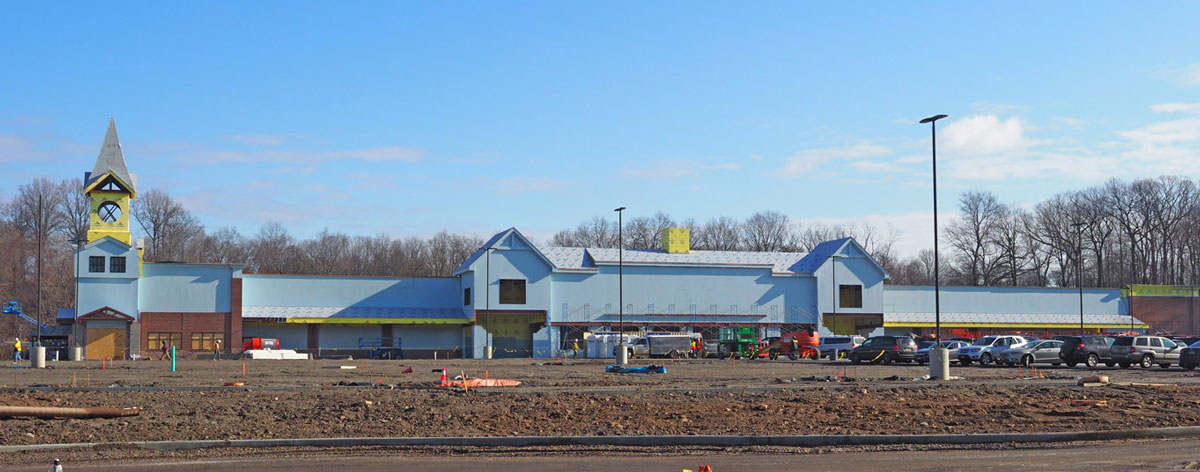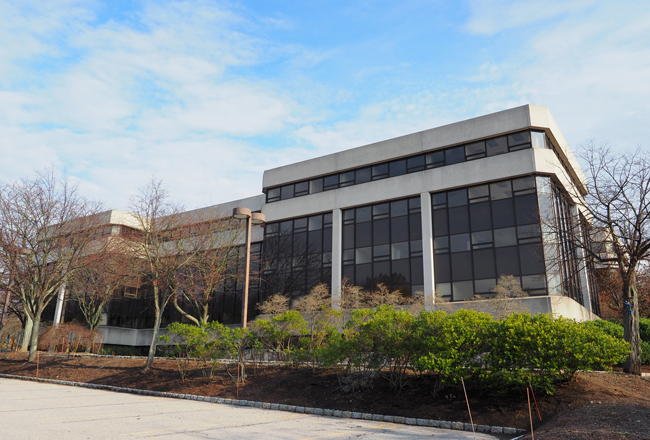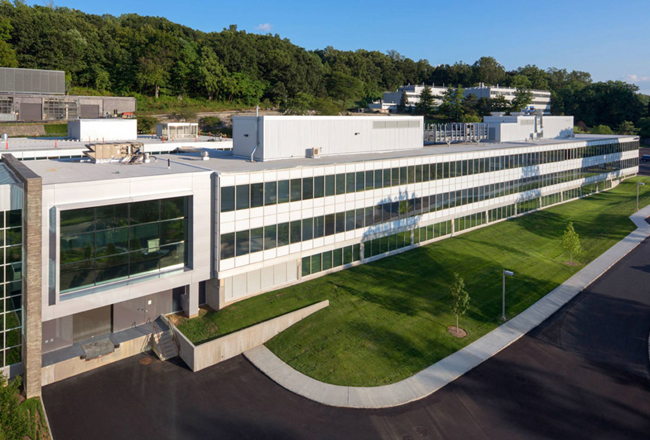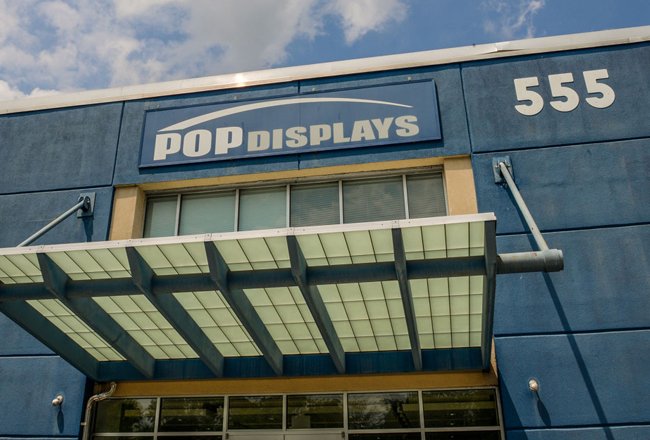By Howard Greenberg – January 17, 2020

The new Wegmans takes shape on Corporate Park Drive. Photo by Bob Rozycki
We have all heard about retail becoming omnichannel.
That is when you can buy online, pick up or return at the store or order online while at the store, so that the online and the retail components work together to satisfy the customer.
The Westchester County commercial real estate market is well into its omnichannel phase.
Apartment developments are taking place in former office buildings in central business districts (CBDs) and in suburban office parks. Medical tenants continue to be one of the largest occupiers in the office leasing market. A new 125,000-square-foot Wegmans supermarket is under construction in a former office park on the Platinum Mile and Dannon Yogurt has opened a new headquarters in a multistory retail building in White Plains. All the different product types are morphing and blending to the benefit of the overall market.
We need to look at the 2019 performance of the Westchester office market through a different lens than we have historically.
In the last 10 to 12 years, Westchester has downsized its multitenant office space inventory by about 6 million square feet or almost 20% through demolitions of obsolete buildings and repurposings to medical and other uses. Without increasing tenant demand for space, we have reduced our supply significantly.
In response, asking and taking rents have begun to rise. Our office market is now significantly healthier than it has been in many years. The balance has shifted from our decades-long tenant’s market to a landlord’s market. Space options for tenants are much fewer than they have been and building owners may have more than one tenant vying for the same space.
Overall, 2019 has been a very good year in the office leasing market. Countywide availability finished at 20.1%, 1 percentage point lower than in 2018 and the lowest since 2014. The overall direct vacancy rate finished at 16.2%. Note that vacancy numbers are always lower than availability numbers that include spaces that are rent-paying but are being offered for sublease.
Leasing activity increased 4.2% from 2018 to about 1.8 million square feet. In the last quarter of the year, some 510,000 square feet of space was leased, up 48% from a quiet third quarter.
Renewal volume grew 35.2% over 2018 to 850,000 square feet. There were 107 renewals in 2019 compared with 80 in the previous year, which helps to reinforce the theory that tenants have fewer space options to choose from considering the county’s reduced supply of space.
There were 42 fewer new leases in 2019 vs. 2018, leading to a decline of 8.8% or 85,000 square feet in this category. All statistics are courtesy of Karolina Alexandre, research manager for Newmark Knight Frank.
The east side (also known as the Platinum Mile) has been the most active submarket throughout 2019 and the White Plains CBD has also had good leasing activity. The available space inventory in these submarkets is reducing significantly.
Average rents on the east side are rising and the vacancy rate is 9.1% in this submarket. Leasing activity in this submarket totaled 720,000 square feet or 40% of the countywide total leasing in 2019.
The current direct vacancy rate is 9.2% in the White Plains CBD. In more than 30 years representing tenants and landlords in Westchester, I have never seen a single-digit vacancy rate in any submarket.
Where the west side has lagged in the last few years in both rental rates and leasing velocity, both statistics are improving.
Larger office buildings with the largest amenity packages, including 800 and 1133 Westchester Ave. and Centre at Purchase, are in the mid-$30s asking rents that are high numbers for our suburban buildings.
These user-friendly buildings are commanding significantly higher rents than the typical 100,000-square-foot generic buildings on Westchester Avenue. The large buildings (with up to 2,000 employees occupying them) can offer not only cafeterias, but gyms, golf simulators, conference/training rooms, hair salons, 24/7 security and other amenities that are attractive to tenants and their employees.
In recent years, as unemployment has dropped and companies are finding it more difficult to recruit employees, the location, attractiveness and amenities of a building and its surroundings have become increasingly important to companies as they compete for talented employees in a tight labor market.
Tenant buildouts are costing significantly more today as tenants demand higher-quality workspaces. Lots of glass, modern open kitchens and higher-quality finishes are in demand. The price of construction materials and construction labor continues to rise as all the activity in major multifamily developments competes for these resources.
Repurposings of office buildings are still increasing, including 3 Westchester Park Drive (160,000 square feet) to multifamily; 104 Corporate Park Drive (118,000 square feet) to medical; the former Avon building in Rye (173,000 square feet) likely to senior living; and the former March of Dimes building (113,000 square feet) to become the Windward School. Developers are creating new sites by tearing down existing buildings and replacing them with new uses.

3 Westchester Park Drive. Photo by Bob Rozycki
Westchester Park Drive (formerly known as Gannett Drive) will soon have offices, apartments and the 210,000-square-foot LifeTime Fitness, all within a very short walk of each other. This is a true example of the live/work/play environment that is taking hold throughout the U.S. The apartments will be built on the site of a former office building and LifeTime is on the site of the former Gannett newspaper printing plant and offices.
With the Toll Brothers apartments almost ready and Wegmans construction well underway on Corporate Park Drive, both of these former office parks (where 581,000 square feet of vacant office space has been or will be demolished) will be fully activated with new residents and shoppers in the near future. These modern facilities are replacing empty, obsolete office buildings that were the first to be built on the Platinum Mile in the 1970s and early 1980s.
The rezoning process for a private STEM (Science, Technology, Engineering and Math) school for the 1.2-million-square-foot former IBM campus in Somers is continuing. This vacancy makes Westchester look like a middling market statistically. If the school deal closes, the entire complex will come off the vacancy statistics and the countywide vacancy rate will reduce to 11.8%. This would be an historic low for Westchester and will more accurately reflect market conditions.
Repositionings of office buildings are also boosting deal velocity and rental rates. Repositioning includes updates and improvements to lobbies, public corridors, rest rooms, gyms, cafeterias and other amenities. It also includes improvements to building exteriors, entries, landscaping and parking areas. Repositioning is taking an old, neglected building and investing in significant capital improvements to re-present a fresher, higher-quality offering to the market.
On the west side, Tarrytown Corporate Center is going through a repositioning and so will Talleyrand as its new owner takes over. Also, 570 Taxter Road has leased up well as its repositioning continues.
CEO Tim Jones of Robert Martin Co. recently mentioned that he is talking to an office tenant for part of 555 White Plains Road in Tarrytown. He may turn the existing building into a mixed-use format rather than execute his original plan to demolish it and replace it with a fitness center and self-storage. This is the first I have heard about anyone considering returning an almost empty office building to the multitenant office market and is very encouraging.
Ginsburg Development is repositioning the Westchester Financial Center and has rebranded it as City Square. It is accomplishing this, in part, by repurposing about 180,000 square feet of former office and education space at 11 Martine Ave. to multifamily use. This is a bellwether project in the CBD.

The Westchester Financial Center in downtown White Plains. Photo by Peter Katz
Due to its floor size and configuration this is one of the few office buildings that can be converted to residential and its repurposing has caused a significant reduction in the CBD office inventory, which is already a very tight submarket.
Within a block of the Metro-North station it is a logical place for a TOD (ransit oriented development), and also involves the repurposing of the former Pace University Graduate School and multiple floors of office space into new residential product. The residential and office buildings on this full city block will share a private landscaped plaza located above street level which is a great amenity in a CBD location.
Hopefully, the new retail and restaurants the developer is planning for the ground floor at 50 Main St. will activate this now dark space and improve the dated look at the most important entrance to White Plains.
There will soon be four large apartment buildings on Bank Street and the former AT&T building on Hamilton Avenue is slated to be redeveloped as residential. These will all help to activate this part of the CBD with a cohort of new young people.
Due to a combination of higher rental rates, parking costs and the many municipal and office building parking structures that are not user-friendly to clients, some law firms have been moving out of the CBD to suburban locations. As Class A CBD rents are in the very high $30s to low $40s plus parking of $2.40 to $3 per square foot, the asking rent delta between CBD and suburban space can be as high as $17 per square foot. That is a huge differential in our market and by far the largest rent delta between CBD and suburbs I have ever seen. Many admit in this day of emails and texting there are significantly fewer clients coming to offices.
Some other businesses, notably those looking primarily to attract millennial employees, are now attracted to the CBD for its Metro-North access and the local restaurant and bar offerings to accomplish their hiring and employee retention goals. Gateway’s great new lobby and front entry, Ginsburg’s repositioning of City Square and Ivy Realty’s skillful renovations of White Plains Plaza are giving some CBD buildings a wow factor that we have not seen since 360 Hamilton Ave. was repositioned many years ago.
Office and industrial tenants who have been in the county for a long time will need to be re-educated to this new norm in terms of availability and pricing. Many of them may also need to open themselves up to new submarkets to find enough space alternatives.
Landlords have faced increasing operating costs and real estate taxes over many years without any rent growth to offset these increased expenses.
They also face significant increases in construction costs, so this year’s increased rental rates have not provided windfalls for them. However, the market is moving in a profitable direction after several years of generally flat rents in the suburban buildings. CBD rents have already been rising at $2 to $3 per square foot per year since 2016.
As rental rates continue to rise and working remotely increases, tenants will have to think about the space they really need, what their workflow will be and what they are willing to pay. As vacancy rates are reduced, companies will have less availability of expansion space, so it is even more important that they project their needs properly at the outset for lease terms that will generally be seven years or more.
In White Plains, Yonkers and New Rochelle thousands of apartment units are in the approval pipeline, have been approved, are under construction or in the lease-up phase.
All the buildings I have heard of are leasing ahead of schedule at rents in excess of their projections. Approvals and construction will go on for several years on these projects, so there is not a significant risk of too many apartments being dumped on the market at the same time, which would result in a large excess of inventory and subsequent discounting of rental rates.
With a few small exceptions, all this residential development is rental apartments. Millennials and young marrieds are very attracted to the apartment lifestyle and particularly to new construction with contemporary kitchens, open floor plans and lots of amenities, including roof decks, pools, barbeque and outdoor areas, game rooms and business centers.
Many new apartment tenants in Westchester are coming from New York City and other areas and local empty nesters are a major market factor as well. Millennials and young couples are attracted by Westchester’s rents that are significantly lower than those in Manhattan for much nicer and newer apartments with large amenity packages.
Many of these buildings are within walking distance of Metro-North stations with short commutes to New York City. Most of Westchester’s existing apartment stock is more than 50 years old without the layouts and amenities that are popular.
It will be interesting to see how quickly the new Toll Brothers apartments on Corporate Park Drive will lease up. They offer a suburban alternative to those who do not want to live in a CBD setting.
The new buildings coming up in the county add some excitement to the neighborhoods around the CBD and soon to the suburban office parks that will be mixed-use parks.
For the first time in my memory, large national developers are very enthused about our market. Publicly traded Lennar Corp. (one of America’s largest homebuilders) and Toll Brothers are building multiple large projects in Westchester that has historically been a market dominated by local developers. Large New York developers such as RXR, Rose Associates, Extell and Fisher Brothers are jumping into Westchester.
While Mack-Cali no longer owns any office or flex/industrial space in Westchester, its Roseland multifamily division has plans into the city of White Plains to demolish 1 Water St. and build a new apartment building on the site that is next to the Metro-North station.
When the White Plains Mall is demolished and redeveloped into four residential buildings with a central public green space it will greatly improve a full city block that has been an eyesore for decades. It needs to empty the rest of its tenants, most notably the Department of Motor Vehicles, so demolition can move forward. But its demolition permit recently expired after a year with no activity.
Submissions were due to White Plains in November for the redevelopment of four city-owned land parcels surrounding the Metro-North station. These parcels are at the main gateway to the city and are an important piece of the CBD development puzzle. Determining what will be built there has been a long process, especially since multiple private developers had approached the city with their own concept plans regarding such development 10 or more years ago.
The $92-million renovation of the station is almost complete, but the area is in need of retail, services, restaurants and bars as there will soon be four large apartment buildings along Bank Street alone whose closest retail stores and restaurants are on Mamaroneck Avenue.
County Executive George Latimer signed a 99-year land lease for the North 60 site with Fareri Associates for its biotech/medical/office campus in Mount Pleasant. The approval process with the municipality will likely take about two years followed by the buildout of the campus infrastructure and actual buildings.

BioMed’s Ardsley campus.
New York Medical College has expanded its biotech incubator and Robert Martin Co. hired Larry Gottlieb, a Hudson Valley economic development executive, to work on bringing biotech tenants to the nearby Robert Martin flex parks.
BioMed Realty Trust received approval of more than $900,000 in sales tax exemptions from the Westchester County Industrial Development Agency (IDA) for its $38 million renovation of portions of its Ardsley Park life sciences campus in Greenburgh.
BioMed had done a market study that showed smaller biotech companies and startup companies cannot afford the significant expense of fitting out their own laboratory spaces. This inhibits the growth of startups that are beyond the incubator stage and have no path to the real estate they need at the next stage.
BioMed determined it will build out 97,000 square feet of currently vacant space into new “plug and play” laboratory and office space that will open in late 2020 and mid-2021. This will be a much-needed bridge to help our biotech companies grow. This is a key advance for this industry that has no other space available to it until North 60 is online.
Hospital for Special Surgery’s 50,000-square-foot facility is up and running at 1133 Westchester Ave. and Simone Development purchased 104 Corporate Park Drive with Montefiore as a tenant for a full-building pediatric medical and cancer treatment facility. Montefiore has leased an additional 50,000 square feet at 555 Taxter Road for medical use and now occupies about 127,000 square feet at the building.
ENT and Allergy Associates relocated its White Plains office to 222 Bloomingdale Road with much better parking than at its old facility at 75 South Broadway.
The industrial market continues to be beyond tight and high-priced.

UPS leased the entire former Saks Fifth Avenue Distribution Center in Yonkers, about 450,000 square feet of space. This was in conjunction with the current tenant POP Displays relocating its manufacturing to Georgia. UPS could not find this amount of distribution space anywhere else in Westchester County if not for this fortuitous event
Early in 2019, Mack-Cali sold its Elmsford Distribution Center to Realterm Logistics, a Maryland-based company with a national portfolio of properties serving the transportation industry.
This 387,000-square-foot industrial park was built primarily in the late 1950s and it sold for $181.50 per square foot, well more than office buildings have sold for in recent years. Given the state of the warehouse market in Westchester, the new owner expects (and will get) a considerable upside from present rents that averaged $11.77 modified gross per square foot at the time of the sale.
Later in the year, after multiple smaller sales, Mack-Cali sold its entire remaining Westchester portfolio of primarily flex buildings to Robert Martin Company, which developed all of the properties before selling them to Mack-Cali in 1997. This blockbuster sale, the largest in Westchester County’s history, was for 3.1 million square feet for a total of $487.5 million or $152 per square foot.
Danone, the parent company of Dannon Yogurt, moved into approximately 80,000 square feet at The Source (a multi-level retail building formerly fully occupied by Fortunoff) for its U.S. headquarters. This tenant is a pioneer in creating creative office space in a retail setting, surrounded by The Westchester mall, a hotel and restaurants at the entrance to I-287. It moved from a suburban office building in Greenburgh and went the retail route when it could not find any office space in the CBD that satisfied its requirement for a cool new space for its young workforce.
It was announced that the 65,000-square-foot Stop & Shop supermarket space at New Roc City in New Rochelle will be leased by Audi for an automobile dealership upon the supermarket’s lease expiration in early 2020. This long-term lease will kick off a major renovation of New Roc and will fill a large retail space that would otherwise be very difficult to lease.
These are two examples of what is happening to counter the thousands of store closings throughout the U.S. and to bring new uses to large retail spaces. Both involved rezoning the locations to permit the new uses.
I anticipate that 2020 will be another good year for the market as office space continues to tighten, new multifamily housing continues to come online and developers continue to find creative uses for sites where obsolete buildings once stood.
“The Westchester County office market has turned a corner in 2019,” Alexandre said. “Leasing activity has been strong, space inventory is down, demand is stable and the market is healthier than it has been in decades. Trends in repurposing of obsolete office buildings, repurposing of office sites to other uses and the continuing strong demand in the medical sector have shown that the trends that have developed in the last few years are continuing to improve the health of the market. We anticipate that 2020 will continue in this direction, solidifying the gains that we have seen this year.”
Howard E. Greenberg is president of Howard Properties Ltd. in Valhalla. He has more than 33 years of experience as a commercial real estate broker and tenant representative in Westchester County. He can be reached at 914-997-0300 or howard@howprop.com.